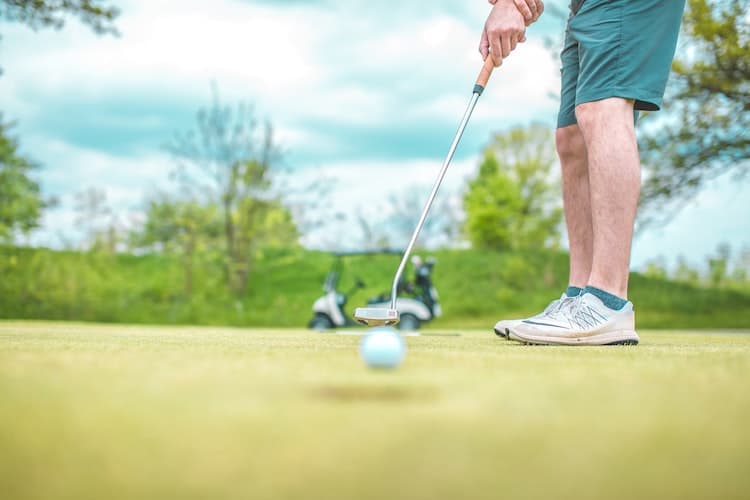
With golf season right around the corner, it’s essential to get your mind and body prepared.
Growing up in New York and knowing that my golf season was limited by the weather helped me develop some strategies to ensure I was ready to play my best golf as soon as the season allowed.
Here are some of those tips and tricks so that you don’t waste a single day of the golf season.
Develop a Strong Strength Training Routine
Fitness experts will tell you that the physical strength of your body will have a major impact on your ability to hit the ball a long way and to do it consistently.
As long as you have some basic dumbbells or bands, you can do exercises to encourage better leg strength, arm strength, and muscle tone.
It’s best to devise a physical fitness routine that you can do consistently throughout the offseason. This doesn’t mean doing a few squats, push-ups, or curls the day before you head back out on the golf course.
The strength training routine should also work on your stomach muscles and abdomen to ensure that your core is as efficient and quick as possible in the swing.

Winter Cardio Is Key
Winter cardio is something that many golfers forget to do.
Jumping on the treadmill a few days a week and walking “9 holes” will pay off when the golf course doors open. Golf is not the most physically demanding sport, but getting through nine holes or 18 holes of golf will be considerably easier if your heart is in better condition.
Many times in the early part of the golf season, players will start to make mistakes when they get to holes 15 and 16. This is not necessarily because of your golf swing but because your body and heart are tired.
Schedule Putting Practice
It may sound ridiculous to add putting practice to your schedule, but it is not!
Set up an area in your home where you can work on your putting and practice for at least a half hour per week. Feel free to split this up into 3 ten-minute sessions.
If you buy the right putting mat that will hold your attention and challenge you, chances are you will see much better results and want to practice more often.
When you head out to the course in the spring, the green will be bumpy, but your consistent stroke will only help that first round of the new season.
Swing As Often As You Can
Professional golfers often have the advantage here because they have large studios where they can work on their golf game and watch the progression of their swing on a launch monitor. Many amateur players do not have this same opportunity.
However, there are often indoor driving ranges or a space in your garage where you can at least swing a club. Even if you can swing just a few times per week, you will help make the start of the golf season much easier on you.
Go For a Golf Club Fitting
People often like to argue that a golf club fitting is for players searching for new clubs, but this is not the truth. Golf club fittings are for golfers that want to ensure their equipment is the best possible choice for them.
Going to a fitting could mean you come home with a new club, but it could also be a slight tweak to a loft or lie of a golf club in your bag.
Getting on a launch monitor and having a fitting expert determine if you are using equipment that supports your goals is a really smart choice.

Regrip Your Golf Clubs
Whether you do it yourself or you have someone do it for you, regripping your golf clubs is a great way to start the new season. When your golf clubs have slippery grips on them, your grip pressure will increase, and you may struggle with releasing the golf club.
When regripping clubs, ensure you have the right size grip and the proper material and thickness. Golf club regripping is an investment but one that is well worth taking if you are keeping your equipment through the golf season.
Brush up on Rules
Rule changes happen in golf more frequently than they once did. If you want to be sure you are adequately prepared to follow the rules on the course, take a glance through a new rule book. Many golfers have this idea that the rules are there to punish you; however, they are there to help you.
Knowing the rules of golf will help you understand what your options are should you hit a bad shot. Trust me on this one – for many years, I didn’t have enough of an understanding of the more detailed rules, and I ended up dropping the ball in areas where it didn’t make much sense.
When you know the rules and your options, you can save several strokes this season.
Set a Goal for The Year
What is your goal for this golf season?
Having the goal in place and developing it in the off season will help you set up a plan and figure out a way to achieve it. The goals don’t always have to be scoring-related.
You may find that you want to play golf more on Wednesdays or that you want to meet some new golf partners. These are all good goals. However, in the months when you can’t play golf because of the weather, you can think about your goals and how you will accomplish them.
Chipping Practice in The House
We mentioned putting practice in the house, but I also highly recommend working on your chipping.
The key here is to find foam golf balls and a small hitting mat or even a carpet where you can hit some wedge shots. The key here is to take an effortless motion and try to make clean contact.
Chipping practice does not need to be anything fancy or expensive. Even taking a small bucket from the garage or a bowl from the kitchen and trying to chip the foam balls into that will be enough to get the lower body and upper body working together.
The key to chipping is often the tempo, which establishes it at the perfect time of year.
Mentally Prepare Your Game
The mental game is such a huge component and one that many amateur golfers neglect to pay attention to.
If you want to mentally prepare your game, it is essential to work on it. There are books and videos out there that will teach you the proper mindset and alternative ways to look at scoring.
I highly recommend developing a pre shot routine that is the same every single time. In addition, it may be worth looking into some type of app or device that will help track your stats when the season starts.
Knowing if you are hitting greens and fairways or if your putting is terrible can give you more direction as to what to work on. Over time, mental preparedness is going to pay off even more than physical preparedness.
The golfers on the PGA Tour that are winning each week are mentally tougher than other players on tour. At some point, everyone is able to make good golf shots, but the mentally tough will win.
Check The Fundamentals Before They Turn Into Bad Habits
When you finally get to start hitting golf shots, make sure that you use alignment sticks to check that the golf ball’s direction is as straight as you think it is. These first few weeks of the golf season are when you start to notice issues with the bad habits sneaking back up.
Many players jump out on the golf course after several months off and start swinging as hard as they possibly can. Of course, this is not necessary, and until you get your setup, stance, posture, grip, and tempo down, don’t attempt to do all that much.
Starting the golf season unprepared may end up causing you some frustration when it comes to lowering scores and having a successful year. Take it slow in the beginning, and be methodical about the swings you are taking and the practice you are putting in.
In the end the work you do on the fundamentals will pay off the most.


